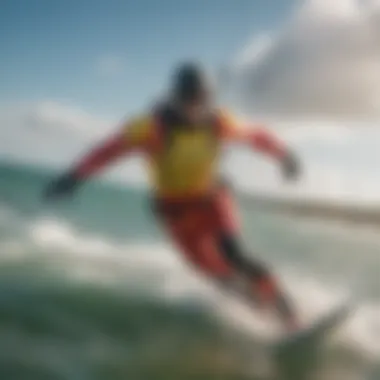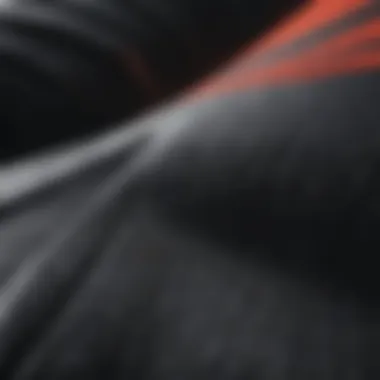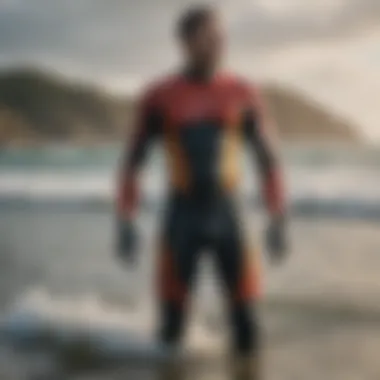The Importance of Colourful Wetsuits in Kitesurfing


Intro
Kitesurfing is not just about the thrill of the ride; it is also an expression of personal style and identity. As the sport has grown in popularity, the relevance of colourful wetsuits in kitesurfing has surged. This guide delves into the various aspects that make vibrant wetisuits an essential component of kitesurfing gear.
From aesthetics to performance, wetsuits do more than keep you warm. The design choices impact visibility on the water, safety, and even environmental considerations. Athletes often select their wetsuits based not just on function, but also on colour and style that reflect their personality. This intersection of design and functionality is crucial for both novices and experienced riders alike.
This article encompasses the significance of colour in wetsuits, examines the materials used in their construction, and discusses how design enhancements can affect overall performance. Moreover, it addresses the cultural aspects that influence what riders choose to wear and features leading brands innovating in this space. Understanding these details allows kitesurfers to make informed decisions that suit their individual needs and preferences.
Prolusion to Colourful Wetsuits
The introduction of colourful wetsuits marks a significant shift in both aesthetics and functionality within the realm of kitesurfing. Historically, wetsuits focused primarily on thermal protection without much attention given to design or colour. However, as the sport of kitesurfing evolved and gained mainstream popularity, the demand for personal expression through gear became increasingly apparent. Colourful wetsuits not only serve to enhance one’s individual style but they also play a critical role in safety and visibility on the water.
Kitesurfers often navigate large bodies of water where visual cues are essential. Brightly coloured wetsuits can help differentiate riders from their surroundings, especially in varied lighting conditions or amidst choppy waves. In a sport that involves high speeds and dynamic movements, having a wetsuit that stands out can aid in safety, making it easier for fellow surfers, instructors, and safety personnel to spot individuals in action.
Moreover, the choice of a colourful wetsuit reflects the rider's personality and preferences, contributing to a culture that celebrates vibrant expression. When selecting a wetsuit, considerations about its colour and design are now seen as pivotal elements. Not only do these factors influence personal branding, but they also align with performance needs and comfort levels. Understanding how these aspects intertwine enhances the overall kitesurfing experience.
This section sets the stage for a detailed exploration of how colourful wetsuits have transformed kitesurfing. With this context, we will now look at the evolution of wetsuit designs, showcasing how these garments have advanced in style and function over the years.
The Evolution of Wetsuit Designs
Wetsuit designs have evolved significantly from their inception in the mid-20th century. Original models were utilitarian, mainly crafted for warmth and practicality. As kitesurfing emerged as an extreme sport, the need for more specialized and performance-oriented wetsuits became clear. Manufacturers began experimenting with different materials, cuts, and innovative features to accommodate the unique demands of kitesurfing.
Initially, wetsuits were monochromatic or sported very limited colour palettes. The advent of newer materials like neoprene and advanced manufacturing techniques allowed brands to merge functionality with style. Vibrant colours, patterns, and designs started appearing, appealing not only to aesthetics but also fostering a sense of community among kitesurfers. Riders embraced the idea that their wetsuits could communicate their spirit and approach to the sport.
Now, colourful wetsuits are commonplace. They come in a myriad of designs, from gradient patterns to bold prints, making it easier for a rider to express individuality. In addition, brands are increasingly focused on customization options, allowing riders to choose colours and designs that resonate with them personally. This evolution has undoubtedly enhanced the experience of kitesurfing, making it more inclusive and engaging for enthusiasts across the spectrum.
Aesthetic Appeal versus Functionality
The intersection of aesthetic appeal and functionality represents a nuanced aspect of wetsuit design. Initially, it may seem that these two elements are at odds; however, they can and do coexist harmoniously. A colourful design does not merely serve as decoration; it can also enhance performance and usability.
For instance, one factor to consider is the material used. High-quality, technologically advanced neoprene offers both comfort and warmth, while also facilitating the incorporation of bright colours and patterns. Some wetsuits are equipped with features like thermal lining, which protects against cold water, paired with striking designs. This combo allows kitesurfers to feel confident and stylish while ensuring that they maintain heat during their sessions.
Additionally, the way a wetsuit is designed for mobility and flexibility can affect a kitesurfer's performance. Many modern colourful wetsuits use strategic paneling and construction techniques to improve movement without compromising on insulation. The aesthetics of vibrant colours can thus be intertwined with practical needs, such as ensuring a good fit that permits unrestricted motion.
In this regard, choosing a wetsuit involves a careful analysis of how colour and design relate to one's kitesurfing experience. Selecting a wetsuit is no longer just about keeping warm but rather about embracing a holistic approach that celebrates beauty while prioritizing performance.
Material Composition of Wetsuits
The material composition of wetsuits is critical in the realm of kitesurfing. A wetsuit's primary function is to provide insulation and protection in varying water conditions. Each element of the wetsuit's fabric plays a significant role in determining its performance, comfort, and durability. Selecting the right materials can make the difference between a great session on the water and a disappointing experience. Therefore, understanding the types of materials used in wetsuits is fundamental for kitesurfers aiming to maximize their performance and enjoyment.


Types of Neoprene Used
Neoprene is the standard material for most wetsuits, owing to its excellent thermal insulation properties. It comes in different grades and thicknesses, which cater to various conditions and preferences. The two main types of neoprene used are:
- Standard Neoprene: This traditional material is effective for insulation and reasonably flexible. It works well for a range of temperature conditions but may be heavier when wet.
- Super Stretch Neoprene: This advanced neoprene type offers enhanced flexibility and comfort. It uses a lighter composition that dries faster, making it popular among high-performance athletes. The stretch factor allows for greater movement, crucial when navigating the rigors of kitesurfing.
In addition to these types, some brands are experimenting with eco-friendly neoprene made from limestone, which reduces the environmental impact of wetsuit production.
Additional Materials for Enhanced Performance
To boost the performance of wetsuits, various supplementary materials have been integrated into their designs. These elements not only enhance protection but also improve the overall user experience. Key materials include:
- Lining Materials: Plush or thermal linings can be added to provide extra warmth. Materials like micro fleece are common, adding comfort while also promoting heat retention.
- Sealants and Tape: Seam tape and liquid sealants ensure watertight seams, significantly improving insulation. This minimizes water entry, which is crucial in colder waters.
- Coating Technologies: Some wetsuits feature coatings that provide additional water resistance or UV protection. This is particularly beneficial for those spending prolonged periods under the sun and in water.
Understanding the materials and how they interact with your body and the environment can guide you in selecting a wetsuit that meets your needs. Whether it be for warmth or flexibility, the right material composition plays an essential role in the overall experience of kitesurfing.
Choosing the Right Wetsuit for Kitesurfing
Choosing the right wetsuit for kitesurfing is crucial for all kitesurfers, from beginners to advanced athletes. The suitability of a wetsuit directly impacts one's comfort, performance, and overall enjoyment on the water. This section outlines the important elements and benefits related to kitesurfing wetsuits, including material, fit, and design.
Factors to Consider
Thickness
Thickness is one of the most significant factors in wetsuit selection. This measurement refers to the neoprene's density, usually indicated in millimeters. Thicker suits provide more insulation, which is essential for colder water conditions.
A thicker wetsuit offers better warmth, making it an advantageous choice for kitesurfers venturing into colder climates or during winter months. Common thicknesses range from 2mm to 6mm. While thicker suits are better at retaining heat, they may restrict movement. This restriction can be a disadvantage during intense riding sessions. Therefore, it's essential to strike a balance between warmth and mobility.
Fit and Comfort
Fit and comfort are paramount when selecting a wetsuit. A well-fitting wetsuit allows for adequate movement while ensuring that no water leaks in. A snug fit minimizes the water that enters the suit, enhancing insulation and overall comfort.
Different brands may have distinct fits; it is helpful to try various options. Additionally, features like sealed seams and flexible neoprene can greatly contribute to comfort. A comfortable wetsuit can significantly affect performance since restricted movement can lead to fatigue.
Temperature Ratings
Temperature ratings indicate how suitable a wetsuit is for varying water temperatures. These ratings help kitesurfers choose appropriate gear according to conditions. A well-rated wetsuit offers the right thermal protection, promoting comfort and focus.
Moreover, knowing these ratings can help prevent hypothermia in colder waters. Keep in mind that factors like wind chill and personal tolerance levels can also affect how a wetsuit performs in different temperatures.
Functionality of Colourful Design


Choosing a colourful design does not only involve personal style but also influences functionality. A vibrant colour scheme can enhance visibility, making kitesurfers more noticeable in the water, which is a crucial safety aspect.
Certain colours reflect light differently, impacting heat retention on sunny days. Overall, incorporating function into the aesthetics presents kitesurfers with a unique opportunity to express individuality while maintaining safety and performance.
The Psychology of Colour in Water Sports
The realm of water sports, especially kitesurfing, is not just about physical prowess. It also significantly involves psychological elements, with colour being a pivotal factor. Understanding the psychology of colour can enhance athletic performance and enjoyment while also ensuring safety on the water. Kitesurfing enthusiasts should be aware of these dynamics when selecting their colourful wetsuits.
Impact on Mood and Performance
Research indicates that colour can affect mood and overall performance in sports. Bright colours like yellow or orange can evoke feelings of energetic enthusiasm, which may boost confidence during challenging sessions on the water. Conversely, darker colours might impart feelings of seriousness and focus, which can be beneficial in more technical maneuvers.
Studies suggest that an athlete’s choice of colour can influence their emotional state and performance outcomes. For instance, wearing a bright wetsuit might not only make the athlete feel more vibrant but could lead to an invigorated mindset, potentially improving their kitesurfing experience. Wetsuits in shades like red can stir adrenaline, while cooler tones like blue might promote a sense of calm and control.
Visibility and Safety Considerations
Ensuring visibility in water sports is crucial. The combination of vibrant colours and patterns on wetsuits serves a practical function beyond aesthetic appeal. Brightly coloured wetsuits can significantly enhance safety, making it easier for fellow kitesurfers and boaters to spot participants in various water conditions.
- Increased Detection: High-visibility colours reduce the risk of accidents on the water. Bright orange or neon colours increase the likelihood of being seen, especially in choppy conditions or poor weather.
- Emergency Situations: In the event of an emergency, a colourful wetsuit can help rescuers locate an individual more quickly, improving safety outcomes.
"The use of vibrant colours in wetsuits is a dual-edged sword, its impact resonates beyond personal style—it's about safety and performance on the water."
This is particularly relevant for kitesurfing, which often involves navigating busy shorelines and water traffic. Athletes often overlook the importance of colour for safety, but it can be as critical as the choice of kite or board.
Ultimately, selecting a wetsuit with attention to colour affects not only personal style but also the overall kitesurfing experience, combining performance, safety, and individual expression.
Popular Brands and Their Contributions
The landscape of kitesurfing equipment is ever-changing, influenced significantly by the contributions of prominent brands. These companies shape the market, delivering not only innovative designs but also emphasizing sustainability and performance. This section explores the key roles these brands play in enhancing the overall experience of kitesurfing through their colourful wetsuits.
Innovative Designs in the Market
The competition in kitesurfing wetsuits has given rise to remarkable innovations. Brands like O'Neill, Mystic, and ION consistently push boundaries, transforming wetsuit aesthetics and functionality. Their unique designs incorporate bold colours and patterns, making them visually striking on the water.
One significant trend is the move towards hybrid wetsuits. These suits combine the flexibility of shorties with the protective qualities of full suits, catering to varying weather conditions. Further, the use of 3D printing has started to appear in production. This allows for precise fits and intricate designs that traditional methods cannot match. Brands are integrating technology to enhance comfort and reduce water resistance.
Wetsuits like the O'Neill Hyperfreak focus not just on vibrant looks but also on performance. They feature minimal seams and include quick-dry technology. Such elements demonstrate how aesthetics can be married to functionality.
Sustainability in Wetsuit Production
Sustainability in wetsuit production is becoming an urgent priority for many leading brands. Notably, companies like Patagonia and Rip Curl emphasize eco-friendliness by using neoprene derived from limestone instead of petroleum. This shift addresses environmental concerns associated with traditional wetsuit materials.


Additionally, brands are innovating with recycled materials. Some are now using discarded fishing nets and other ocean plastics in their suit production. This not only aids in waste reduction but also promotes responsible consumption among consumers. The focus on durability also ties into sustainability, as longer-lasting products mean less frequent replacements, further minimizing waste.
Moreover, certifications like Global Organic Textile Standard (GOTS) indicate a brand's commitment to sustainability. This choice provides consumers with peace of mind. Several brands are clearly signaling that colorful wetsuits can be both stylish and environmentally responsible.
"Brands that prioritize sustainable practices not only contribute to environmental welfare but also resonate with the values of today's conscientious consumers."
Maintenance and Care of Colourful Wetsuits
Maintaining and caring for colourful wetsuits is crucial not only for the longevity of the garment but also for performance and safety. A well-maintained wetsuit can enhance warmth, buoyancy, and flexibility. Moreover, regular care preserves the vibrant colours, ensuring that the wetsuit looks good while in use, which is important for many kitesurfers who value aesthetics. The maintenance routine involves both cleaning and proper storage methods, which will be discussed in this section.
Cleaning Techniques
Cleaning a wetsuit properly is key to extending its life. Saltwater, sand, and chlorine can deteriorate the fabric over time. Here are effective cleaning techniques:
- Rinse Immediately: After each session, rinse the wetsuit with fresh water. This removes salt and sand that can cause wear.
- Use Mild Soap: When deeper cleaning is needed, use a mild wetsuit soap. Avoid harsh detergents that can break down neoprene. Mix the soap with fresh water and gently scrub the wetsuit.
- Hand Wash: Never machine wash. Rather, soak the wetsuit in a bathtub filled with the soap solution. Let it sit for 15-30 minutes then gently scrub.
- Thorough Rinsing: After washing, rinse thoroughly with cool, fresh water to ensure no soap residue remains.
- Dry Carefully: Do not wring out the wetsuit. Instead, lay it flat or hang it to dry in a shaded area. Direct sunlight can fade colours and harm the material.
Storage Best Practices
Proper storage of a colourful wetsuit ensures it remains in great condition when not in use. Follow these best practices:
- Avoid Folding: Never fold the wetsuit for storage. Instead, hang it on a wide hanger to maintain its shape and prevent creases.
- Use a Wetsuit Bag: If possible, store the wetsuit in a special wetsuit bag that allows for breathability. This helps prevent mould and mildew.
- Keep Away from Heat: Store in a cool, dry place. Avoid storing near heaters or in direct sunlight as heat can damage the neoprene and fade colours.
- Check for Damage: Regularly inspect the wetsuit for any tears or signs of wear. Early detection can save significant repair costs later.
"Invest time in cleaning and storing your wetsuit. This small effort can significantly impact your performance and enjoyment on the water."
By incorporating these cleaning techniques and storage best practices, kitesurfers can ensure their colourful wetsuits remain functional and visually appealing. This attention to maintenance not only benefits individual comfort but also emphasizes the importance of investing in high-quality gear.
Culmination
The importance of colourful wetsuits in kitesurfing extends beyond mere aesthetics. They represent a unique fusion of style and function that resonates with both participants and enthusiasts of the sport. By exploring the various dimensions of colour in wetsuit design, this article illuminates how such choices go beyond visual appeal.
Future Trends in Wetsuit Design
In the coming years, we can expect significant advancements in wetsuit design. Manufacturers are shifting their focus towards integrating technology with style. New materials and production methods will likely emerge to enhance flexibility, durability, and user comfort. Trends may include:
- Biodegradable Materials: Environmental concerns are promptng brands to experiment with eco-friendly options. We might see more wetsuits that decompose rather easily after their lifecycle.
- Smart Wetsuits: Innovations may introduce sensors that help monitor the wearer's body temperature and hydration levels. Such features would add a layer of safety and enhance the overall experience.
- Customisable Designs: With advances in printing technology, kitesurfers may be able to design their wetsuits with personal flair, adding unique patterns and colours that reflect their individuality.
Incorporating these elements not only supports performance but also addresses the growing demand for sustainability and personalization. Brands will need to stay attuned to these shifts to remain competitive.
Final Thoughts on Colourful Wetsuits
Ultimately, choosing a colourful wetsuit is more than a style decision; it reflects the wearer's personality and commitment to the sport. These vibrant pieces of gear carry significance in terms of safety and visibility, making them essential for kitesurfers navigating the waters. As kitesurfing continues to evolve, so will the conversation around what swimmers wear.
Overall, every aspect mentioned throughout this article reinforces the idea that colourful wetsuits are a critical component in the kitesurfing experience. They combine functionality with personal expression, enhancing both performance on the water and individual identity in the kitesurfing community.
"The wetsuit you choose not only affects your comfort but also your connection to the vibrant world of kitesurfing."
This guidance serves to empower kitesurfers, encouraging careful consideration and appreciation of their gear choices. The future appears bright for this niche within water sports, combining utility, sustainability, and personal expression.







